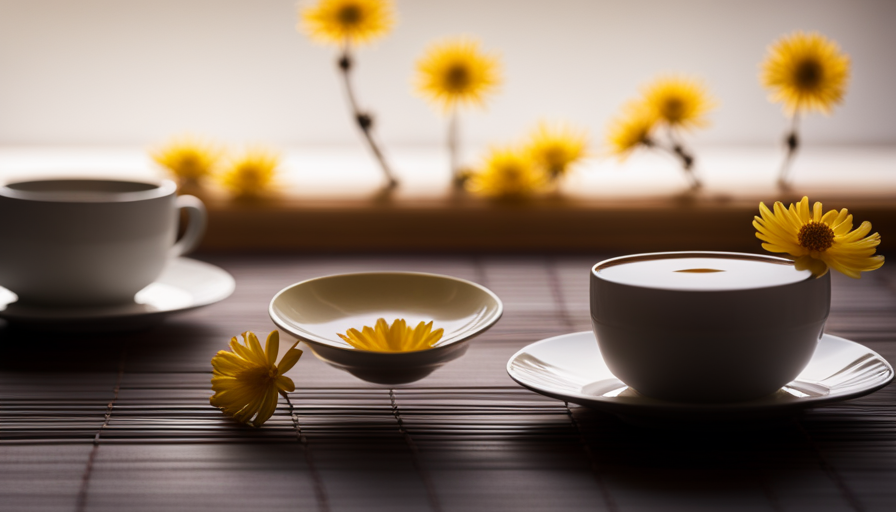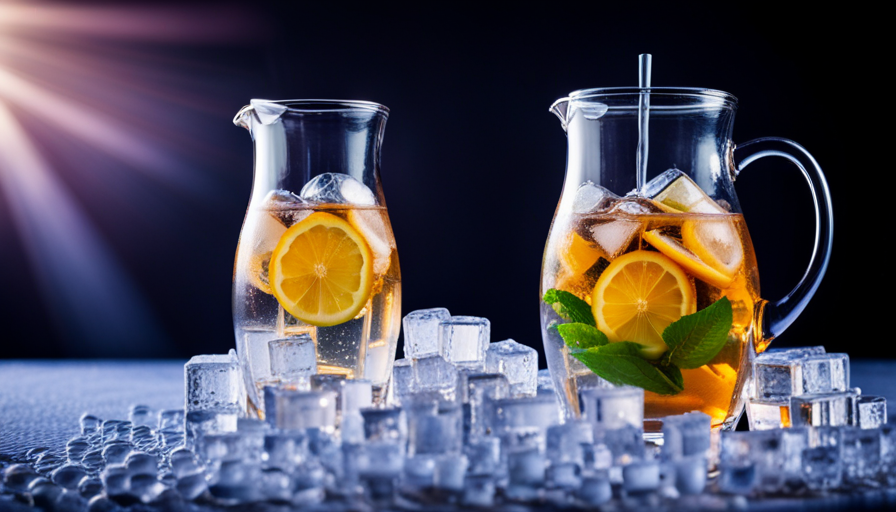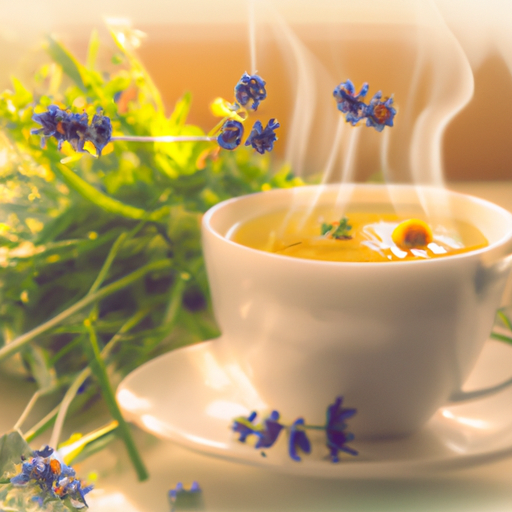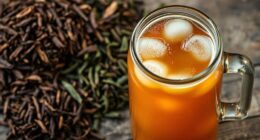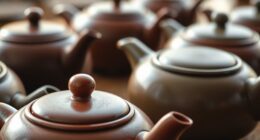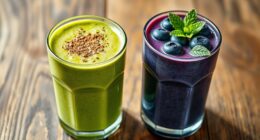Are you prepared to try the most exceptional herbal tea you have ever had? Prepare to be amazed by the secret to achieving the ideal blend of flavor and scent.
It’s time to uncover the mystical art of brewing herbal tea. Now, you might be thinking, ‘How much water should I use with my herbal tea bag?’ Well, hold on tight because I’m about to reveal the answer that will revolutionize your tea-drinking experience.
In this article, I will guide you through the precise measurements, steeping techniques, and essential tips to create a heavenly concoction that will tantalize your taste buds. So, grab your favorite herbal tea bag, and let’s embark on a journey to discover the ultimate infusion of flavors. Get ready to savor every sip and indulge in the pure bliss of herbal tea perfection.
Key Takeaways
- The recommended ratio for brewing herbal tea is 1 tea bag for every 8 ounces of water.
- Adjust the ratio and brewing time according to personal preference for desired strength.
- Using less water creates a stronger and more flavorful cup of tea.
- Experiment with different herbal blends and brewing times to discover unique flavors and aromas.
Understand the Recommended Ratio
To make the perfect cup of herbal tea, you’ll want to remember the recommended ratio of tea to water. The key to a well-balanced brew lies in personalizing your brewing experience.
Herbal tea offers a plethora of benefits, such as soothing properties, antioxidants, and various flavors to satisfy your taste buds. For a standard cup of herbal tea, I recommend using one tea bag for every 8 ounces of water. This ratio ensures that the flavors and beneficial compounds are extracted properly, giving you a delightful and refreshing beverage.
However, keep in mind that this is just a starting point. As you become more familiar with different herbal teas, you can experiment with adjusting the ratio to suit your personal preference. By doing so, you’ll be able to create a cup of herbal tea that is tailored to your taste.
Consider Personal Preference
When it comes to brewing herbal tea, adjusting the water amount based on desired strength is crucial. Personally, I find that using less water results in a stronger and more flavorful cup of tea. On the other hand, using more water creates a milder taste. It’s all about finding that perfect balance that suits your taste buds. Don’t be afraid to experiment with different ratios until you discover your own personal preference.
Adjust the water amount based on desired strength
For a stronger herbal tea, use less water. Adjusting the water amount is crucial in determining the strength of your tea. If you prefer a bolder flavor, decrease the amount of water you use when brewing your herbal tea bag. This allows the tea leaves to infuse more intensely, resulting in a more robust and concentrated taste.
Additionally, adjusting the brewing time can also contribute to the strength of your tea. Longer steeping times can extract more flavor from the herbs, creating a stronger brew.
To further enhance your tea-drinking experience, don’t be afraid to try different herbal blends. Each blend has its own unique flavor profile, and experimenting with different combinations can help you find your perfect taste.
So, go ahead and play around with different ratios to discover the strength that suits your preferences best.
Experiment with different ratios to find your perfect taste
Finding your perfect taste is as easy as experimenting with different ratios. When it comes to herbal tea, the water to tea ratio plays a crucial role in determining the flavor profile. By adjusting the amount of water you use, you can create a brew that suits your preferences.
Here are some key factors to consider when finding the right water to tea ratio:
- Start with a 1:1 ratio and gradually increase or decrease the amount of water based on your taste preferences.
- Keep in mind that different teas may require different ratios, so be open to trying various combinations.
- Experiment with hot water at different temperatures to understand the impact on flavor.
Understanding the importance of water temperature and finding the perfect ratio will help you create the ideal cup of herbal tea. By exploring these variables, you can unlock a world of unique flavors and enjoy a truly personalized tea experience.
Now, let’s move on to the next section about using fresh, filtered water.
Use Fresh, Filtered Water
To make the perfect cup of herbal tea, make sure you’re using fresh, filtered water. Experimenting with different brewing methods can greatly enhance the flavor and aroma of your tea. But no matter which method you choose, using filtered water is essential.
Not only does it remove impurities and chlorine that can alter the taste of your tea, but it also ensures a clean and pure flavor. The benefits of using filtered water are numerous – it enhances the natural flavors of the herbs, allows the tea to steep properly, and prevents any unwanted taste or odor from affecting your brew.
So, before you start brewing your tea, don’t forget to fill your kettle with fresh, filtered water. This will ensure that you’re starting off on the right foot and setting yourself up for a delightful tea experience.
Now, let’s move on to boiling the water to the right temperature.
Boil the Water to the Right Temperature
Once you’ve got your fresh, filtered water ready, it’s time to boil it to the perfect temperature for brewing the most flavorful cup of herbal tea.
Boiling time and water temperature are crucial factors in extracting the full potential of the herbs and creating a delicious infusion. The ideal temperature for herbal tea is usually between 200°F and 212°F (93°C – 100°C). Different herbs may require slight variations, so it’s essential to refer to the specific instructions for your chosen herbal tea blend.
Boiling the water for around 5 minutes should be sufficient to reach the desired temperature. Remember, boiling water not only helps to release the herbal flavors but also ensures any impurities are eliminated.
Now that you have perfectly boiled water, let’s move on to why steeping time matters for the best cup of herbal tea.
Steeping Time Matters
I can’t stress enough how important it is to follow the recommended steeping time on the tea bag packaging. It’s there for a reason, to ensure you get the perfect cup of tea every time.
But don’t be afraid to adjust the steeping time to suit your personal taste. If you prefer a stronger flavor, let it steep a little longer. And if you like a milder flavor, reduce the steeping time.
It’s all about finding that perfect balance of flavor and aroma that satisfies your palate. So go ahead, experiment and make your tea experience truly delightful.
Follow the recommended steeping time on the tea bag packaging
Remember, when steeping your herbal tea bag, make sure to follow the recommended steeping time on the packaging, just like a delicate flower blooming at the perfect moment.
It’s essential to understand the different types of herbal teas and their unique benefits. Herbal teas are known for their natural healing properties and soothing effects on the body. Each blend offers a distinct flavor profile and specific health benefits, such as promoting relaxation, boosting immunity, or aiding digestion.
By adhering to the suggested steeping time, you allow the tea leaves and herbs to release their full potential, resulting in a well-balanced and flavorful cup of tea.
So, take a moment to read the instructions on your tea bag packaging and discover the optimal steeping time for your chosen blend. This knowledge will empower you to adjust the steeping time for a stronger or milder flavor, which we’ll explore in the next section.
Adjust steeping time for stronger or milder flavor
To achieve a bolder or more subtle taste experience, you can easily modify the steeping time according to your preference. Adjusting the brewing time allows for a personalized cup of herbal tea that perfectly suits your taste buds. Here are three simple steps to adjust the steeping time for a stronger or milder flavor:
-
Increase the steeping time: For a more robust flavor, let the tea bag steep for an additional minute or two. This allows the herbs to infuse the water more fully, resulting in a stronger taste.
-
Decrease the steeping time: If you prefer a milder flavor, reduce the steeping time by a minute or two. This prevents the herbs from overpowering the tea, giving you a more delicate and subtle taste.
-
Adjust brewing temperature: Another way to control the strength of your herbal tea is by adjusting the brewing temperature. Higher temperatures extract more flavor, while lower temperatures produce a gentler brew.
By adjusting the steeping time and brewing temperature, you can create a cup of herbal tea that perfectly suits your preferences.
Now, let’s move on to the next section and explore how to avoid wasting leftover tea.
Don’t Waste Leftover Tea
When it comes to leftover brewed herbal tea, I’ve learned some valuable tips for storing it properly. First, I always make sure to let the tea cool completely before transferring it to an airtight container and storing it in the refrigerator. This helps preserve its freshness and flavor for longer.
Secondly, if I have a large amount of leftover tea, I like to freeze it in ice cube trays and use the frozen cubes to make refreshing iced tea later on.
Lastly, I’ve discovered some creative ways to use leftover brewed tea, such as using it as a base for homemade popsicles or adding it to smoothies for an extra burst of flavor.
Tips for storing leftover brewed herbal tea
For best results, simply transfer any leftover brewed herbal tea to an airtight container and refrigerate it promptly. Storing tea bags in the fridge is a great way to preserve their flavor and ensure that you can enjoy a refreshing cup of tea later on. When storing the tea, make sure to remove the tea bags from the water to prevent them from becoming soggy and diluting the flavor. To help you keep track of your tea collection, here is a handy table to guide you:
| Tea Flavor | Date Brewed |
|---|---|
| Chamomile | 05/15/2022 |
| Peppermint | 06/01/2022 |
| Lemon Verbena | 06/10/2022 |
By storing your leftover brewed herbal tea properly, you can extend its shelf life and maintain its delicious taste. Now, let’s explore some creative ways to use leftover brewed tea without wasting a drop.
Creative ways to use leftover brewed tea
Leftover brewed tea can be transformed into unexpected culinary delights that’ll leave your taste buds tingling. Instead of throwing away those tea leaves, consider repurposing them in creative ways.
One option is to use the leftover tea leaves to create your own DIY herbal tea blends. Mix them with other herbs and spices to customize your own unique flavors. You can experiment with different combinations like lavender and chamomile for a calming blend, or mint and lemon for a refreshing twist.
Another idea is to incorporate the tea leaves into baked goods, such as cookies or cakes, to add a subtle hint of flavor. The possibilities are endless when it comes to finding creative ways to use leftover brewed tea.
Now, let’s move on to the next section and discover how to enjoy your perfect cup of herbal tea.
Enjoy Your Perfect Cup of Herbal Tea
When it comes to enjoying your perfect cup of herbal tea, I believe it’s all about sitting back, relaxing, and savoring the flavors of your brew.
Each sip should transport you to a state of tranquility and bliss. Don’t be afraid to experiment with different herbal tea flavors and combinations, as this is where the true magic happens.
Allow yourself to be enchanted by the endless possibilities and let your taste buds guide you on a delightful journey.
So go ahead, indulge in the aromatic symphony of herbs and spices, and let the soothing elixir of herbal tea be your ultimate source of comfort and pleasure.
Sit back, relax, and savor the flavors of your brew
Indulge in the rich, soothing flavors of your herbal tea bag brew and let your worries melt away. There’s nothing quite like sitting back, relaxing, and savoring the flavors of a perfectly brewed cup of herbal tea. As you take that first sip, close your eyes and let the warmth and aroma envelop you, transporting you to a state of tranquility.
To enhance your tea-drinking experience, why not try incorporating some relaxation techniques? Take a deep breath, inhaling the delightful scents, and exhale slowly, releasing any tension. As you sip your tea, imagine each sip nourishing your body and mind, providing a moment of calm in your busy day.
Here’s a table to help you explore the health benefits of different herbal teas:
| Herbal Tea | Health Benefits | Flavor Profile |
|---|---|---|
| Chamomile | Promotes relaxation and aids in sleep | Floral and soothing |
| Peppermint | Eases digestion and relieves headaches | Refreshing and minty |
| Ginger | Reduces inflammation and boosts immunity | Spicy and warming |
So go ahead, experiment with different herbal tea flavors and combinations, and let your tea journey take you to new heights of relaxation and enjoyment.
Experiment with different herbal tea flavors and combinations
Try mixing and matching various flavors of herbal infusions to create your own unique and refreshing cup of relaxation, because the possibilities are endless and you deserve a little extra flavor in your day. Experimenting with unique flavor combinations is a delightful way to discover new favorites and expand your tea horizons.
Not only do different herbal teas offer a wide range of tastes, but they also come with their own set of health benefits. For example, chamomile tea is known for its calming properties, while peppermint tea can aid digestion and provide a refreshing boost. Combining these two flavors can create a soothing blend that promotes relaxation and supports digestive health.
Other combinations like lavender and lemon balm or ginger and turmeric can offer their own unique benefits. So go ahead and get creative with your herbal tea choices. Your taste buds and well-being will thank you.
Frequently Asked Questions
Can I use tap water to brew herbal tea?
Yes, you can use tap water to brew herbal tea, but there are benefits to using filtered water. Filtered water ensures tap water safety by removing impurities, resulting in a cleaner and purer taste for your tea.
What is the ideal temperature for boiling water for herbal tea?
The ideal temperature for boiling water for herbal tea is around 200°F. This allows for the perfect steeping time, maximizing the flavor and benefits of the tea. Using filtered water ensures a clean and pure taste.
How long can I keep leftover brewed herbal tea?
Leftover brewed herbal tea should be stored in an airtight container in the refrigerator for up to 24 hours. It is not recommended to reuse leftover brewed herbal tea as it may lose its flavor and beneficial properties.
Can I use the same tea bag for multiple cups of tea?
Reusing tea bags is a common practice, but did you know that it can significantly reduce the flavor and health benefits of your tea? Opt for loose leaf tea instead, it’s richer in taste and packed with more antioxidants.
Does the type of herbal tea affect the amount of water needed for brewing?
The type of herbal tea can indeed affect the amount of water needed for brewing. Different herbal teas have different flavors and strengths, which may require adjustments in water ratio to achieve the desired taste and herbal tea benefits.
Conclusion
In conclusion, crafting the perfect cup of herbal tea is an art that requires attention to detail and a touch of passion. By following the recommended ratio, considering personal preference, using fresh filtered water, boiling it to the right temperature, and steeping for the right amount of time, you can unlock the full potential of your tea bag.
And remember, don’t waste any leftover tea, savor every sip! Embrace the heavenly aroma, the soothing warmth, and the burst of flavors that’ll make you feel like you’re floating on a cloud of pure bliss. Indulge in this delightful experience and let the magic of herbal tea transport you to a state of tranquility and serenity.


